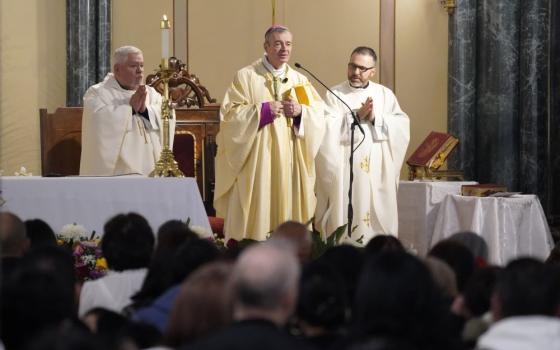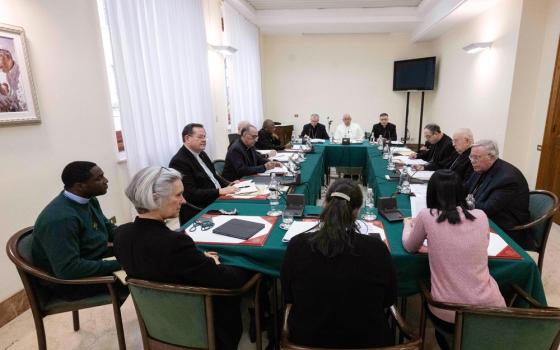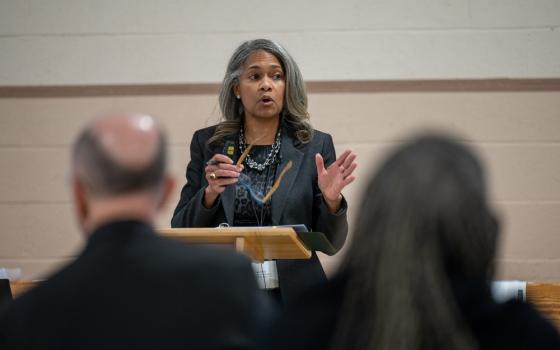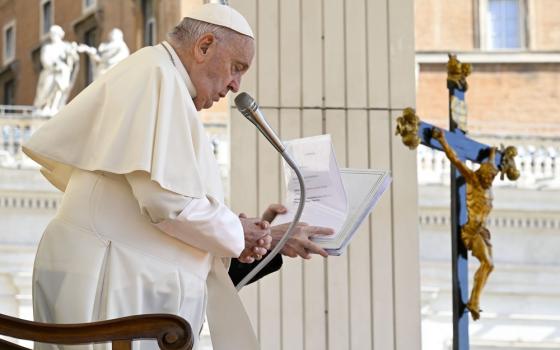By now, it's an "All Things Catholic" tradition to run down the top under-covered Vatican stories of the year. The idea is not to flag the year's most celebrated events or personalities, because plenty of other news agencies do that. Rather, I try to lift up storylines that otherwise flew below radar but that were actually fairly important.
If I were compiling a list of the biggest Vatican stories of the year, for instance, the beatification of Pope John Paul II on May 1 would probably be near the top. Yet it doesn't make the cut as an "under-covered" event, because it's hard to believe anybody who picked up a newspaper in May 2011, or who watched TV that day, could have missed it. Similarly, a document from the Pontifical Council for Justice and Peace on reform of the international economy, as well as the Vatican's diplomatic spat with Ireland, both were important stories, but they were hardly overlooked.
Conversely, if this were a list of "over-covered" stories, probably the No. 1 entry would be the Vatican's on-again, off-again reconciliation with the traditionalist Society of St. Pius X. Aside from the fact that we've been down this road before -- enticed by breathless reports of a deal, only to watch it unravel -- the group's sociological footprint doesn't justify the attention. We're talking about less than one-tenth of 1 percent of the global Catholic population, yet their negotiations with Rome are sometimes covered as if it's Roosevelt and Stalin at Yalta.
Instead, what follows is a run-down of 10 stories during 2011 that didn't have much echo, especially in the States, but which tell us something significant. In other words, this is the kind of stuff that armchair vaticanisti everywhere need to know.
By the way, be sure to read on to the end for a bonus feature on the year's top "non-story."
10. Scola to Milan
Cardinal Angelo Scola, 70, was already in the top tier of papal candidates before his June 28 appointment as the new Archbishop of Milan, but that move certainly put a slammer on his status. During the 20th century, two popes were elected from Milan, Pius XI and Paul VI, and several other archbishops of Milan were considered formidable runners. Scola comes off as an extroverted, optimistic, Italian-speaking version of Benedict XVI -- a ferocious defender of Catholic identity, but someone who likes to put the accent on what the church is for rather than what it's against. As a footnote, the appointment also confirms that Communion and Liberation is Benedict XVI's favorite movement. Scola has lifetime ties to the ciellini and is an intellectual disciple of its founder, the late Monsignor Luigi Giussani.
9. Courtyard of the Gentiles
Although it didn't have much traction in the English-language press, the March 24-25 "Courtyard of the Gentiles" event in Paris was a major hit in the Francophone world. Organized by the Vatican's Pontifical Council for Culture, under hyper-erudite Italian Cardinal Gianfranco Ravasi, and co-sponsored by UNESCO, l'Institut de France and the Sorbonne, the gathering brought Christians and secularists into serious dialogue. One sign of success is that a celebrated French agnostic philosopher, Jean Luc Ferry, was so impressed that he requested an urgent meeting with Ravasi to propose that the two collaborate on a book on the Gospel of John. The Paris gathering was the first of what Ravasi conceives as a series of "Courtyard of the Gentiles" events in various parts of the world, intended to demonstrate that religion and secularism need not be enemies.
8. Assisi
Understandably, Benedict XVI's Oct. 27 gathering of 300 religious leaders in the birthplace of St. Francis didn't draw anything like the interest that surrounded Pope John Paul II's first inter-religious summit in 1986. (For that matter, John Paul's own follow-up gatherings in Assisi, in 1993 and again in 2002, didn't generate the same buzz.) Yet Benedict's choice to mark the 25th anniversary of John Paul's historic event with an interreligious summit of his own was arguably just as important as the original because of what it symbolizes: That convening the religious leaders of the world on behalf of peace was not simply a personal whim of John Paul II. Instead, it's become part of the job description of the papacy, something future popes will be expected to repeat. Given Benedict's reputation as a guardian of Catholic identity, it's also significant that he explicitly endorsed interreligious dialogue, and acknowledged "great shame" for occasions when violence has been committed in the name of Christian faith.
7. The Benin Trip
In the absence of a new flap over condoms and AIDS in Africa, Benedict XVI's Nov. 18-20 trip to Benin wasn't a media sensation. Yet popes vote with their feet, meaning that their pastoral and geopolitical priorities are often revealed by where they choose to travel. This was Benedict's second trip to Africa, making it his second most-visited continent after Europe. While in Benin, Benedict unveiled a document containing conclusions from a 2009 Synod of Bishops for Africa, representing a papal game plan for the continent where Catholicism grew by almost 7,000 percent during the 20th century. Benedict endorsed the socio-political agenda of African Catholicism, especially the struggle against corruption, and challenged the bishops to get their own house in order in terms of accountability, transparency and good government. He also extended his outreach to Islam, calling on the church "in every situation, to persist in esteem for Muslims." A telling moment came at Benin's Presidential Palace, where Chancellor Koubourath Osseni, a Muslim woman, hailed Benedict XVI as "an authentic friend of Africa."
6. Viganò to the States
The Oct. 19 appointment of Italian Archbishop Carlo Maria Viganò as the new papal nuncio, or ambassador, to the United States has both a negative and a positive significance. During his run in the government of the Vatican city-state, Viganò carved out a reputation as an effective financial reformer, ramming through streamlined accounting procedures among the Vatican's notoriously independent little fiefdoms. His exile from Rome, as a result of some rather nasty office politics, arguably illustrates what some observers call a "governance gap" under Benedict XVI -- good intentions that sometimes aren't matched by astute administrative choices, which in this case might have meant allowing Viganò to finish what he started. Yet the fact that he's now in the United States means that Viganò is positioned to help the American bishops move the ball on good money management at a time when some observers worry that financial scandals could become the second round of the sexual abuse crisis in terms of a chronic source of turmoil.
5. Tagle to Manila
Like Milan in Italy, Manila in the Philippines is another one of those mega-dioceses whose leader automatically becomes a global point of reference, and usually draws at least a look as a papal contender. That alone would make the Oct. 13 appointment of Archbishop Luis Antonio Tagle, 54, an important move. Yet the choice is revealing for other reasons too, not least that Tagle flies in the face of conventional stereotypes about the type of leader who usually prospers on Benedict's watch. Tagle is a theological and political moderate, associated with a controversial history of the Second Vatican Council (1962-65) whose progressive interpretation Benedict has spent much of his career contesting. Yet Tagle is also known as a talented theologian, a remarkably un-clerical personality, a good listener and someone utterly uninterested in building ecclesial empires -- in other words, not unlike the reputation of Joseph Ratzinger prior to his election to the papacy. In any event, at the tender age of 54, Tagle is positioned to be a major face and voice for Asian Catholicism for a long time.
4. Benedict's four-volume tour de force
Benedict XVI is a teaching pope, a point that's been crystal clear during his 22 foreign trips. By now, papal observers know that the peak moment of every trip is likely to come during a speech to the "world of culture" that usually includes political, intellectual and spiritual dignitaries. These speeches play to terrific reviews, even among those least inclined to sympathy for what Benedict represents. This year brought another case in point in the form of Benedict's Sept. 22 speech to the Bundestag in Berlin. The role of religious groups in a democracy, the pope suggested, is not to "propose a revealed law to the state and to society," but rather to hold up "nature and reason" as reliable sources for moral choices -- including, he stressed, respect for pluralism and diversity. Benedict even threw in a plug for the environmental movement, calling it "a cry for fresh air," a realization that nature contains a moral compass. Der Spiegel called the speech "courageous" and "brilliant," while the left-wing London Guardian encouraged secular greens to see past stereotypes of the pope as "a prissy and repressed German professor." Bundled with earlier speeches in Regensburg in 2006, the Collège des Bernardins in Paris in 2008, and Westminster Hall in London in 2010, the Bundestag address completes a four-volume tour de force of papal reflection on faith, reason and democracy.
3. The 'Pope of Agnostics'
Improbably enough, the constituency that felt the most love from Benedict XVI during 2011 was the secular agnostic crowd. Probably the biggest headline from his September trip to Germany was Benedict's praise for "agnostics who ... suffer because of our sins and are desirous of a pure heart." Such folk, the pontiff said, are actually "closer to the Kingdom of God than 'routine' believers who only see the apparatus of the church without their hearts being touched by faith." Likewise, Benedict's signal innovation during the Assisi gathering was his decision to invite not just spiritual leaders but also agnostics. In his speech that day, Benedict said genuine agnostics are "inwardly making their way towards [God], inasmuch as they seek truth and goodness," and even thanked them because they "challenge the followers of religions not to consider God as their own property, as if he belonged to them, in such a way that they feel vindicated in using force against others." Who would have predicted that a pontiff who was supposed to be "God's Rottweiler," the ultimate cultural warrior, would turn out to be the "Pope of Agnostics"?
2. The crucifix case
In a stunning and utterly unexpected development, the European Court of Human Rights in March reversed its own 2009 ruling and upheld Italy's right to display crucifixes in its public school classrooms. The ruling means that public expressions of religious belief have been found not to conflict with European standards of human rights and freedom of conscience. Although it may not have burned up airwaves in the States, the story has significance far beyond the borders of Europe. Vis-à-vis what Christian tradition talks about as "the world," there have always been two basic schools of thought. One is an "open door" policy, emphasizing dialogue with the world, presuming its goodwill and meeting it halfway. The other is a "fortress" instinct, seeing the world as fundamentally hostile and seeking a more inward-looking church capable of staying true to itself. The ruling by the Court of Human Rights provided a powerful boost for the "open door" approach, suggesting that detente with secularism may be possible after all. The victory also generated fresh ecumenical and interfaith momentum, as it drew support from a cross-section of Christian denominations as well as European Muslims and Jews.
As a footnote, if I were proposing candidates for top religion newsmakers of the year, I would nominate the lawyer who won the crucifix case -- a New York-based expert on European constitutional law and Orthodox Jew named Joseph Weiler. The sight of Weiler standing in the well of the Grand Chamber of the European Court of Human Rights in his kippah, passionately defending Italy's right to keep the crucifix on the wall, has got to rank among the more remarkable bits of interfaith imagery of the year. Weiler also spent much of 2011 working on a new book on the trial of Jesus, which promises to be a major cause célèbre in Catholic/Jewish relations. Among other bombshells, he'll try to persuade fellow Jews that their efforts over 2,000 years to reject the charge of deicide have been misplaced. In a sense that Weiler carefully unpacks, he believes "the Jews" did indeed put Jesus to death, and they were doing exactly what the Lord expected. (His aim is to offer a reading of the trial that renders both Jewish and Christian responses consistent with Scripture -- a project, he readily admits, destined to stir fierce reactions on both sides.)
1. The global war on Christians
2011 opened with the bombing of a Christian church in Alexandria, Egypt, on Jan. 1, which left 23 people dead, and it closed with Christmas Day attacks on three Christian churches in Nigeria, including a Catholic parish where at least 27 people died. In between were numerous other assaults on Christians, including the Oct. 9 "Maspero Massacre" in Cairo, where the Egyptian army opened fire on unarmed Coptic protestors, killing 27 people and injuring hundreds of others. (Adding insult to injury, the state-controlled media in Egypt briefly tried to blame the Copts for the violence, but that effort quickly collapsed in the face of eye-witness testimony.)
Although these episodes were widely reported as they occurred, they were generally interpreted as localized and isolated events, or as part of another narrative -- the aftermath of the Arab Spring in Egypt, or inter-ethnic and sectarian tensions in Nigeria. Yet taken together, what emerges from these atrocities is a picture of a global war on Christians. Today, Christians are by far the most persecuted religious group on the planet; according to the secular Institute for Human Rights, based in Germany, fully 80 percent of all acts of religious intolerance today are directed at Christians. The Organization for Security and Cooperation in Europe estimates that about 200 million Christians now suffer discrimination, harassment and outright violence.
The global war on Christians is also a Vatican story, because the events of 2011 cemented religious freedom as the Vatican's signal social and political concern in the early 21st century. That shift has consequences across the board, including in ecumenical relations. Cardinal Kurt Koch, the Vatican's top official for relations with other Christians, gave a little-noticed but important speech in September proposing "ecumenism of the martyrs" as the new foundation of Christian unity, given that all churches these days are witnessing the rise of a new generation of martyrs.
Sadly, it's a safe bet that the global war on Christians will remain a top storyline in 2012. Whether it continues to be under-covered depends on how thoroughly the rest of the world, perhaps especially those of us in the West, wakes up.
* * *
Bonus feature: top Vatican non-story of 2011
Sometimes a year is remarkable not just for what happened, but for what didn't. In that spirit, I propose "the dog that didn't bark" as the year's top Vatican non-story, by which I mean that 2011 was largely spared the massive public relations debacles which have marred other years of Benedict's papacy.
Consider this brief stroll down memory lane:
- Early 2007 brought the resignation in disgrace of Benedict's choice as the new Archbishop of Warsaw in Poland, following charges that he had been a Communist collaborator. Later in the year, Benedict stirred protest in Brazil by appearing to suggest that the natives of the New World should be grateful for European colonialism and oppression.
- 2008 brought a crisis in Jewish/Catholic relations over use of the traditional Latin prayer on Good Friday for the conversion of the Jews. Benedict eventually amended the prayer in response to Jewish sensitivities, but only after a lengthy public debate.
- 2009 featured a contretemps over the lifting of the excommunications of four traditionalist bishops, including one who's questioned whether the Nazis used gas chambers. It also saw a flap over Benedict's trip to Africa, when the pontiff seemed to suggest that condoms make the AIDS crisis worse.
- 2010 brought the explosion of the sex abuse crisis in Europe, aggravated by a series of ill-timed and explosive comments from Vatican officials. It also saw the surreal "Boffo case" in Italy, in which the Vatican remained inexplicably silent while national media outlets openly asserted that the Cardinal-Secretary of State, the editor of the Vatican newspaper, and the head of the Vatican security service were all involved in a plot to defame a noted Italian Catholic journalist by suggesting he had harassed a woman in order to carry on a homosexual affair with her fiancé.
2006 saw massive Islamic protest over a September speech by Benedict XVI in Regensburg, Germany, that appeared to link Muhammad with violence. The blowback included the firebombing of churches in the West Bank and Gaza Strip, and the shooting death of a nun in Somalia.
Those who have been paying attention realize this is not a complete list, but it's enough to make the point: In previous years, Benedict's Vatican team has occasionally demonstrated a genius for shooting itself in the foot.
Given that history, 2011 was remarkable because the dog of PR meltdowns basically didn't bark.
There was controversy during the past year, of course. Outrage continued to percolate in Ireland over the sex abuse crisis, and a nonprofit legal foundation based in the States announced an appeal to the International Criminal Court seeking to indict the pope and the Vatican over the scandals. Liberal Catholics groused about the new translation of the Roman Missal, and the Vatican's outreach to the traditionalist Society of St. Pius X; conservatives grumbled about the Pontifical Council for Justice and Peace's document on the global economy, especially its support for stronger world governance, including the idea of a global central bank.
Yet to govern is to choose, and inevitably during any 12-month span, the Vatican will make choices that leave somebody unhappy. The striking thing about 2011 is that there was no big-ticket PR miscue that exacerbated these policy debates or that created gratuitous distractions. Benedict XVI did not, for instance, fall into the "condoms trap" during his November trip to Benin, nor was there any new eruption in interfaith relations.
Whether the non-barking dog of 2011 was the result of a new savvy, or simply dumb luck, is perhaps open to debate. Nonetheless, it's the year's top non-story, and one for which Benedict XVI ought to be grateful.
[John L. Allen Jr. is NCR's senior correspondent. His email address is jallen@ncronline.org.]




